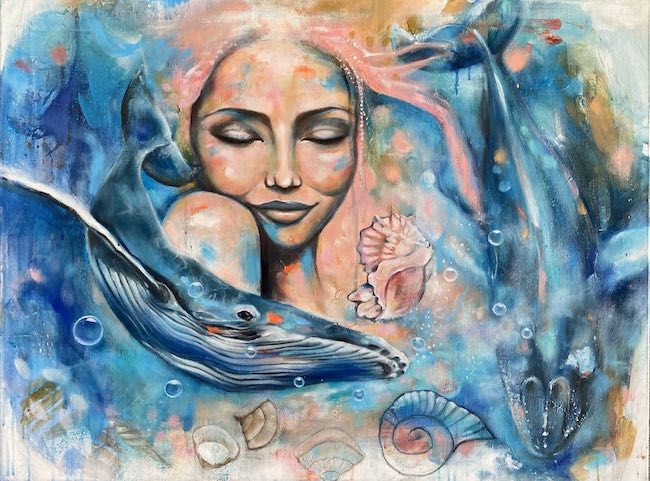Per alcuni creativi il linguaggio artistico diventa un mezzo fondamentale per effettuare quel percorso di conoscenza di sé e del proprio sentire attraverso il quale possano raggiungere una compiutezza personale e nel contempo comunicare all’osservatore l’esistenza di quelle sottili energie spirituali che avvolgono la realtà e la natura. Riuscire a concretizzare quelle sensazioni intangibili richiede una particolare sensibilità e anche la capacità di rendere chiaro un messaggio che spesso può essere letto solo attraverso l’anima, trasformando gli artisti che scelgono questo tipo di approccio pittorico in veri e propri canalizzatori visivi di tutto ciò che di inspiegabile avvolge l’esistenza umana. La protagonista di oggi mescola la sua tendenza figurativa alla necessità interiore di immettere nelle sue tele tutta quella connessione con l’interiorità che le consente di arricchire ogni sua narrazione epressiva di un’atmosfera incantata in grado di coinvolgere le corde più profonde dell’osservatore.
Il Simbolismo, movimento nato intorno agli anni Ottanta del Diciannovesimo secolo, mostrò un’innovativa inclinazione degli artisti che vi aderirono a puntare l’accento sul rapporto tra essere umano e tutte le energie che lo circondano, a volte misteriose altre semplicemente orientate a considerare ogni aspetto dell’osservato e del vissuto come portatore di messaggi e di rivelazioni difficilmente decifrabili; la forma esteriore era fortemente legata alla rappresentazione realista che però veniva arricchita a tutto ciò che apparteneva all’immaginazione, alla mitologia, all’irrealtà o all’esplorazione di dimensioni sconosciute, che veniva descritto con luoghi e forme esistenti eppure trasformate, spesso attinendo figurativamente al mondo dell’oltretomba, della sessualità, delle paure più inconfessate. Odilon Redon, in particolar modo nei disegni e nelle incisioni, raccontò di creature mostruose, senza corpo e spesso mescolando particolari umani a fattezze animali, che di fatto anticiparono le tematiche del Surrealismo proprio in quel suo mettere in evidenza le angosce dell’inconscio; di contro però, nelle tele, metteva in evidenza il lato più magico e poetico di quel contatto con l’interiorità, utilizzando colori chiari e delicati e rappresentando più il sogno che non l’incubo. Hugo Simberg e Arnold Böcklin tesero invece verso il rapporto dell’uomo con l’al di là, inteso come indagine dell’ignoto che appartiene inevitabilmente all’essenza stessa della vita, mentre Gaston Brussière concentrò la sua pittura sulla mitologia nordica, sulla narrazione di personaggi incantati e magici. L’attenzione alle energie sottili della realtà in cui l’uomo viveva si spostò presto sulla sua interiorità, su un sentire che non poteva più rimanere staccato e distante dall’opera d’arte, bensì doveva essere protagonista centrale della rappresentazione creativa; fu proprio su queste basi che nacque l’Espressionismo i cui rappresentanti scelsero di rinunciare a ogni schema accademico sulla prospettiva, sull’utilizzo del colore, sull’equilibrio estetico, pur di dare vita a un tipo di arte che fosse pura manifestazione del loro sentire interiore. Le opere di Henri Matisse e quelle di Marc Chagall si allontanarono da tutto ciò che era esteticamente armonico per dare voce alle emozioni nell’osservare la realtà familiare che andavano a descrivere, spostandosi nel poetico mondo del sogno e lasciando all’osservatore la possibilità di entrare in quella loro dimensione solo attraverso la connessione interiore. In questo punto esatto può essere collocato lo stile dell’artista slovacca Zuzana Freyja che riesce a fondere le due esperienze pittoriche del passato per generare una cifra stilistica in cui l’aderenza formale alla realtà del Simbolismo si fonde a un’innata inclinazione a lasciar emergere tutte le emozioni ricevute dall’ascolto delle energie che appartengono alla natura di cui l’artista si fa messaggera, stimolando l’osservatore a compiere il proprio percorso di ascolto.
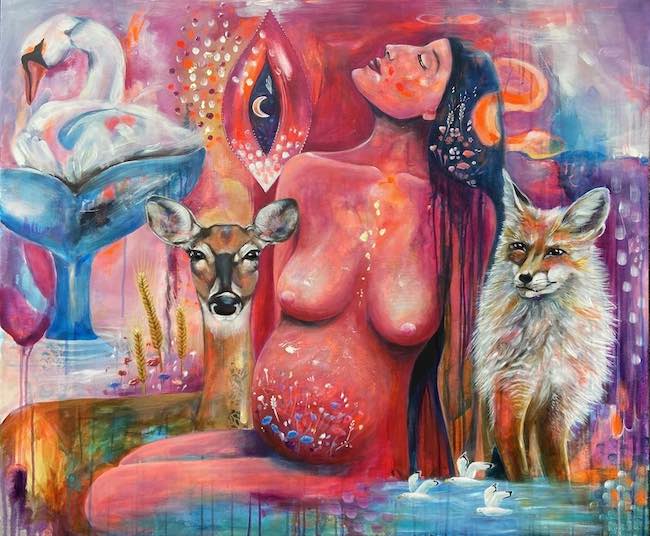
Dal punto di vista espressivo dunque l’Espressionismo sopraggiunge per avvolgere le sue tele di quell’atmosfera magica, irreale, che non tende però verso la cupezza o il mistero del Simbolismo, bensì si apre alla meraviglia dell’evoluzione, della crescente consapevolezza che ogni passo verso l’ascolto di ciò che circonda l’essere umano può diventare un mezzo per innalzarsi verso un grado di coscienza superiore, proprio perché corrisponde a un percorso compiuto dall’artista stessa nel momento in cui ha avvertito la necessità di approfondire la conoscenza e la scoperta del suo vero sé.
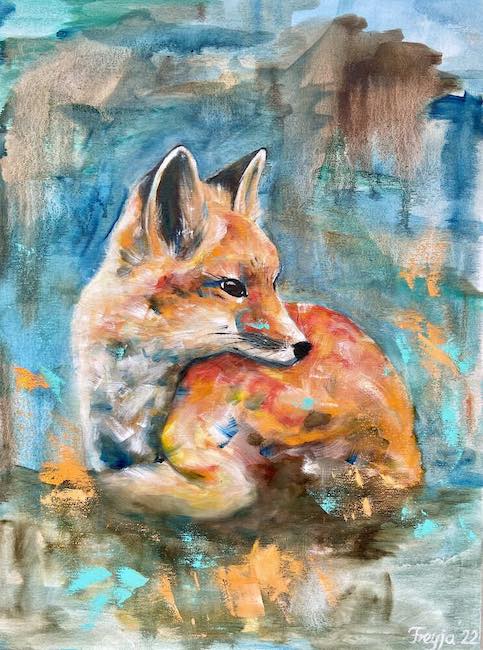
Questo è il motivo per cui la magia, il sogno, sembrano essere elementi imprescindibili dalle sue tele, in cui le protagoniste sono quasi sempre donne, come se l’essenza femminile fosse quella in grado di divenire traino, traghettatrice dell’uomo verso un mondo migliore; Zuzana Freyja conosce bene la sensibilità femminea, è consapevole della forza che molte donne devono trovare per superare le proprie incertezze, i propri dubbi e insicurezze che fanno loro perdere il contatto con l’essenza e così immergersi nella connessione con la natura permette loro di recuperare ciò che istintivamente hanno ma che poi è stato perso a causa del vivere quotidiano.

Le atmosfere incantate in cui l’artista colloca le sue protagoniste sono sfondo ideale per la loro evoluzione personale, per la necessità di entrare in simbiosi con gli elementi più leggeri, come l’acqua e l’aria immergendosi nei quali è possibile trovare il silenzio funzionale a guardarsi dentro, senza lasciarsi intimorire dal dialogo con se stesse, bensì percependolo come una risorsa fondamentale a raggiungere la pienezza dell’essere.
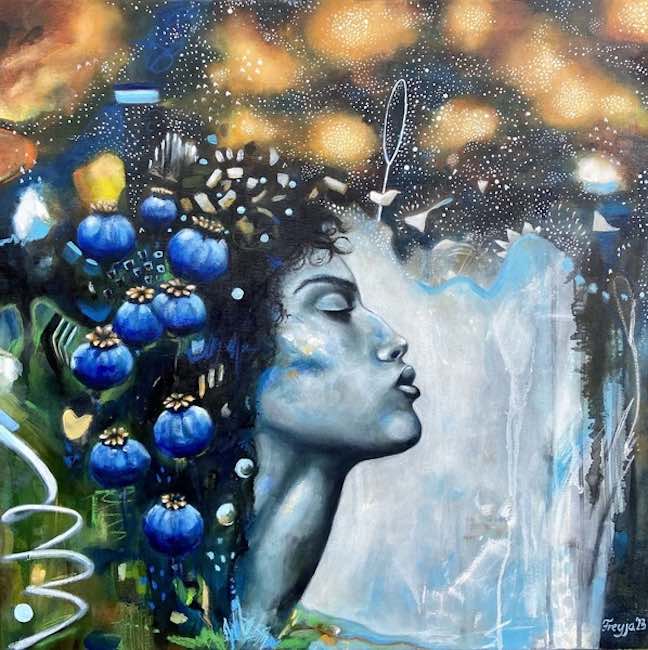
Turning into new potentials è rappresentativo di questo concetto e viene esaltato dall’espressione assorta della donna, quasi come se all’interno di quella dimensione di intensa riflessione potesse trovare la forza di cui ha bisogno per credere in se stessa, avvolta dalla presenza della natura e al contempo spronata dalla forza dell’acqua della cascata che diviene metafora del coraggio necessario a prendere in mano la propria vita per dirigerla verso il cammino migliore. Da un lato dunque la concretezza delle piante che rappresentano le certezze e le radici da cui partire, dall’altro l’irruenza dell’acqua necessaria a rompere schemi preesistenti e solo falsamente rassicuranti, e infine, nella parte alta della composizione, un cielo stellato con nuvole che sembrano più essere desideri da realizzare che non semplici fenomeni atmosferici.
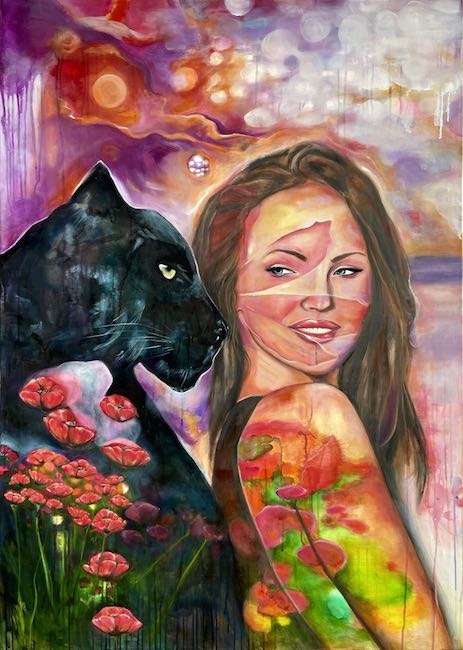
Ma il percorso evolutivo di Zuzana Freyja l’ha condotta anche a studiare l’importanza degli animali guida, che secondo la teoria animista hanno una funzione protettiva nei confronti dell’essere umano, divengono messaggeri di crescita proprio in virtù delle caratteristiche che più si legano all’essenza dell’individuo; questo tema è trattato nella tela Let’s play, dove la protagonista sembra osservare il suo lato più forte, rappresentato dalla pantera, e al contempo anche quello più delicato costituito dai fiori che la circondano e che si intravedono come ombra sul suo volto, perché in fondo, sembra dire l’artista, ogni persona è una mescolanza di differenti nature, la somma di esperienze di vita che in qualche modo sono generate proprio dalla personalità ombra, quella di cui si ignora la presenza ma che in realtà è fondamentale perché è da lei che l’evoluzione inizia ed è verso di lei che prima o poi torna. La consapevolezza pertanto induce la protagonista ad accettare entrambi i suoi lati, quello più delicato e quello più determinato e intrepido, ed è per questo che la sua espressione è serena, giocosa, quasi ormai fosse in grado di mantenere in equilibrio le due sfaccettature, senza sentirsi indebilita dalla prima o indurita dalla seconda.
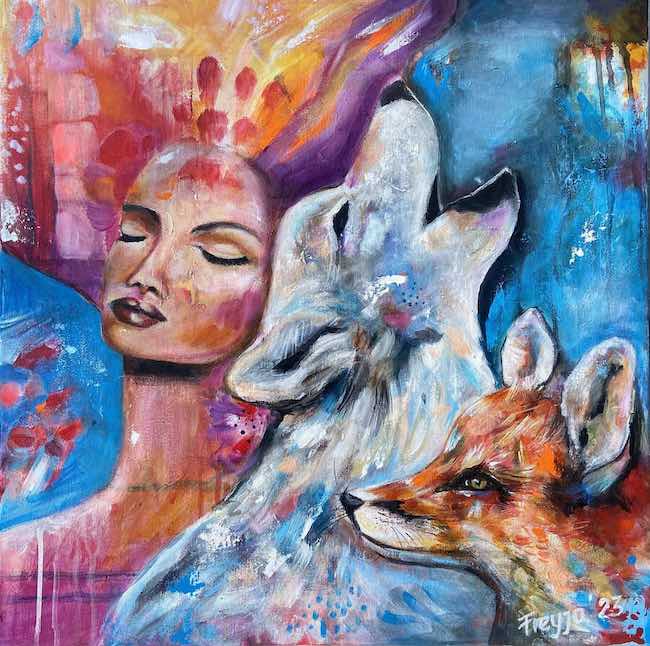
Anche in Soul guides è riproposto il tema degli animali guida ma in questo caso la ragazza appare completamente rapita dalla sensazione di protezione che avverte nel lasciarsi avvolgere dalla presenza del lupo e della volpe, tanto quanto magica è l’atmosfera con cui Zuzana Freyja avvolge l’intera ambientazione, a metà tra l’elevazione spirituale della donna e la realtà della coscienza dello stimolo all’anima costituito dalla connessione con ciò che è più affine alla sua anima, in questo caso le caratteristiche più profonde dei due animali. La gamma cromatica gioca sui colori pastello, è delicata e al tempo stesso vivace, si lega alla dimensione fiabesca, quella in cui la magia diventa regina e protagonista di quel momento di introspezione sognante della donna.
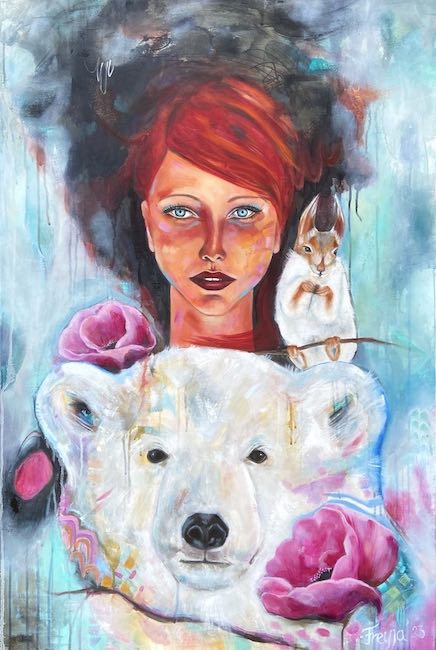
Zusana Freyja ama mescolare varie tecniche pittoriche, misurandosi con colori acrilici, colori fluidi, inchiostri, oli, pastelli, penne, stencil, spesso dipinge con le mani per immergersi appieno nel gesto creativo; ha al suo attivo mostre personali e collettive a Bratislava e all’estero – Praga, Venezia, Milano, Roma – grazie alle quali ha conquistato un pubblico sensibile e aperto all’interpretazione della spiritualità che fuoriesce dalle sue tele.
ZUZANA FREYJA-CONTATTI
Email: freyja@freyjaart.com
Sito web: www.freyjaart.com
Facebook: www.facebook.com/zuzana.mesarosova
Instagram: www.instagram.com/zuzanafreyjaart/
The Expressionist Symbolism by Zuzana Freyja, to cultivate the deepening of the soul and the connection with nature
For some creatives, the language of art becomes a fundamental means of pursuing that path of self-knowledge and feeling through which they can achieve personal fulfilment and at the same time communicate to the observer the existence of those subtle spiritual energies that envelop reality and nature. Being able to concretise those intangible sensations requires a particular sensitivity and also the ability to make clear a message that can often only be read through the soul, transforming artists who choose this type of pictorial approach into true visual channellers of all that inexplicable that envelops human existence. Today’s protagonist mixes her figurative tendency with the inner need to inject into her canvases all that connection with interiority that allows her to enrich each of her epressive narratives with an enchanted atmosphere capable of involving the observer’s deepest chords.
Symbolism, a movement born around the 1880s, showed an innovative inclination on the part of the artists who adhered to it to focus on the relationship between the human being and all the energies that surround him, sometimes mysterious others simply oriented towards considering every aspect of the observed and experienced as a bearer of messages and revelations that were difficult to decipher; the external form was strongly linked to realist representation, which was however enriched with everything that belonged to the imagination, mythology, unreality or the exploration of unknown dimensions, which was described with places and forms that existed yet were transformed, often figuratively drawing on the world of the underworld, sexuality, and the most unconfessed fears. Odilon Redon, particularly in his drawings and engravings, told of monstrous creatures, without bodies and often mixing human details with animal features, which in fact anticipated the themes of Surrealism precisely in his highlighting of the anxieties of the unconscious; on the other hand, however, in his canvases, he put in evidence the more magical and poetic side of that contact with the inner world, using light, delicate colours and representing dreams rather than nightmares.
Hugo Simberg and Arnold Böcklin, tended instead towards man’s relationship with the beyond, understood as an investigation of the unknown that inevitably belongs to the very essence of life, while Gaston Brussière concentrated his painting on Nordic mythology, on the narration of enchanted and magical characters. The attention to the subtle energies of the reality in which man lived soon shifted to his interiority, to a feeling that could no longer remain detached and distant from the work of art, but had to be the central protagonist of the creative representation; it was precisely on this basis that Expressionism was born, whose representatives chose to renounce all academic schemes on perspective, on the use of colour, on aesthetic balance, in order to give life to a type of art that was a pure manifestation of their inner feeling. The paintings of Henri Matisse and those of Marc Chagall moved away from all that was aesthetically harmonious to give voice to the emotions in observing the familiar reality they were describing, moving into the poetic world of dreams and leaving the observer the possibility of entering that dimension only through inner connection. This is exactly where can be placed the style of the Slovakian artist Zuzana Freyja who manages to fuse the two pictorial experiences of the past to generate a stylistic code in which the formal adherence to the reality of Symbolism merges with an innate inclination to let emerge all the emotions received from listening to the energies that belong to nature, stimulating the observer to make his own listening path. From an expressive point of view, therefore, Expressionism arrives to envelop her canvases in that magical, unreal atmosphere, which does not, however, tend towards the gloom or mystery of Symbolism, but rather opens up to the wonder of evolution, of the growing awareness that every step towards listening to what surrounds the human being can become a means to rise towards a higher degree of consciousness, precisely because it corresponds to a path taken by the artist herself at the moment she felt the need to deepen her knowledge and the discovery of her true self.
This is the reason why magic and dreams seem to be inseparable elements of her canvases, in which the protagonists are almost always women, as if the feminine essence were the one capable of becoming a driving force, the ferrywoman of man towards a better world; Zuzana Freyja knows well the feminine sensitivity, she is aware of the strength that many women have to find to overcome their uncertainties, their doubts and insecurities that make them lose contact with their essence, and so immersing themselves in the connection with nature allows them to recover what they instinctively have but which has been lost due to everyday life. The enchanted atmospheres in which the artist places her protagonists are an ideal backdrop for their personal evolution, for the need to enter into symbiosis with the lightest elements, such as water and air, immersing themselves in which it is possible to find the silence that is functional to look inside oneself, without letting be intimidated by the dialogue with oneself, but rather perceiving it as a fundamental resource to achieve fullness of being. Turning into new potentials is representative of this concept and is exalted by the woman’s absorbed expression, almost as if within that dimension of intense reflection she could find the strength she needs to believe in herself, enveloped by the presence of nature and at the same time spurred on by the strength of the waterfall’s water, which becomes a metaphor for the courage needed to take charge of one’s life and direct it towards the best path. On the one hand, therefore, the concreteness of plants representing certainties and roots from which to start, on the other the impetuosity of water necessary to break pre-existing and only falsely reassuring patterns, and finally, at the top of the composition, a starry sky with clouds that seem more like wishes to be realised than mere atmospheric phenomena.
But Zuzana Freyja‘s evolutionary journey has also led her to study the importance of guide animals, which, according to animist theory, have a protective function towards the human being, becoming messengers of growth precisely by virtue of the characteristics that most closely relate to the essence of the individual; this theme is dealt with in the canvas Let’s play, where the protagonist seems to observe her strongest side, represented by the panther, and at the same time the more delicate side of the flowers that surround her and that can be glimpsed as a shadow on her face, because in the end, the artist seems to say, every person is a mixture of different natures, the sum of life experiences that are in some way generated by the shadow personality, the one whose presence is ignored but which is actually fundamental because it is from her that evolution begins and it is to her that it sooner or later returns. Awareness therefore induces the protagonist to accept both of her sides, the more delicate one and the more determined and intrepid one, and it is for this reason that her expression is serene, playful, almost as if she were now able to keep the two facets in balance, without feeling weakened by the former or hardened by the latter.
In Soul guides, the theme of the animal guides is also re-proposed, but in this case the girl appears completely enraptured by the feeling of protection she feels as she allows herself to be enveloped by the presence of wolves, as magical as the atmosphere with which Zuzana Freya envelops the entire setting, halfway between the spiritual elevation of the woman and the reality of the consciousness of the stimulus to the soul constituted by the connection with that which is most akin to her soul, in this case the deeper characteristics of the wolf. The chromatic range plays on pastel colours, it is delicate and at the same time lively, it is linked to the fairy-tale dimension, the one in which magic becomes queen and protagonist of the woman’s moment of dreamy introspection. Zusana Freyja loves to mix various painting techniques, measuring herself with acrylic colours, fluid colours, inks, oils, pastels, pens, stencils, she often paints with her hands to fully immerse herself in the creative gesture; she has solo and group exhibitions in Bratislava and abroad – Prague, Venice, Milan, Rome – thanks to which she has conquered a sensitive public open to the interpretation of spirituality emanating from her canvases.


